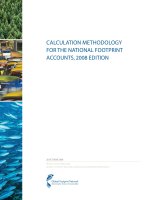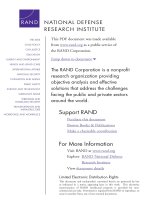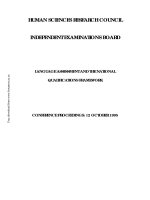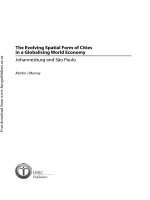Promoting The National Spatial Data Infrastructure Through Partnerships potx
Bạn đang xem bản rút gọn của tài liệu. Xem và tải ngay bản đầy đủ của tài liệu tại đây (110.65 KB, 6 trang )
Promoting the National Spatial Data Infrastructure Through Partnerships (Free Executive Summary)
/>Free Executive Summary
ISBN: 978-0-309-05141-5, 128 pages, 6 x 9, paperback (1994)
This executive summary plus thousands more available at www.nap.edu.
Promoting the National Spatial Data Infrastructure
Through Partnerships
Mapping Science Committee, National Research
Council
This free executive summary is provided by the National Academies as
part of our mission to educate the world on issues of science, engineering,
and health. If you are interested in reading the full book, please visit us
online at . You may browse and
search the full, authoritative version for free; you may also purchase a print
or electronic version of the book. If you have questions or just want more
information about the books published by the National Academies Press,
please contact our customer service department toll-free at 888-624-8373.
Cooperation and partnerships for spatial data activities among the federal government,
state and local governments, and the private sector will be essential for the development
of a robust National Spatial Data Infrastructure (NSDI). This book addresses the nature of
these partnerships and examines factors that could optimize their success.
Copyright © National Academy of Sciences. All rights reserved. Unless otherwise
indicated, all materials in this PDF file are copyrighted by the National Academy of
Sciences. Distribution or copying is strictly prohibited without permission of the National
Academies Press Permission is granted for this material
to be posted on a secure password-protected Web site. The content may not be posted
on a public Web site.
Copyright © National Academy of Sciences. All rights reserved.
This executive summary plus thousands more available at
Promoting the National Spatial Data Infrastructure Through Partnerships
/>1 EXECUTIVE SUMMARY
Cooperation and partnerships for spatial data activities among the
federal government, state and local governments, and the private sector
will be essential for the development of a robust National Spatial Data
Infrastructure (NSDI).
The NSDI is the total ensemble of available geographic information that
describes the arrangement and attributes of features and phenomena on the
Earth, as well as the materials, technology, and people necessary to acquire,
process, store, and distribute such information to meet a wide variety of needs.
The twenty-first century will see geographic information transported from
remote nodes using computer networks to support decision making throughout
the nation. The National Information Infrastructure (NII) will provide the
technology infrastructure to make this possible. There are vast amounts of
spatial data ready to move across the information superhighways today. Timely
use of these data would be difficult due to ill-defined format, quality, and
accuracy. National or regional decision making would be severely impaired
because most data sets are not adequately characterized. This is to be contrasted
by the fact that the NII may well be the most important technology needed to
facilitate a coordinated NSDI.
The Mapping Science Committee (MSC) has recommended
1
that the NSDI
be developed to a level that would support the needs of the nation. The costs of
creating and maintaining digital spatial data are high, so it is particularly
important that spatial data collection not be duplicated, and that data be shared
to fully realize its potential benefits. Largely for these reasons, the National
Performance Review (prepared under the guidance of Vice President Gore)
urged the formation of spatial data partnerships
1 EXECUTIVE SUMMARY 1
About this PDF file: This new digital representation of the original work has been recomposed from XML files created from the original paper book, not from the
original typesetting files. Page breaks are true to the original; line lengths, word breaks, heading styles, and other typesetting-specific formatting, however, cannot be
retained, and some typographic errors may have been accidentally inserted. Please use the print version of this publication as the authoritative version for attribution.
Copyright © National Academy of Sciences. All rights reserved.
This executive summary plus thousands more available at
Promoting the National Spatial Data Infrastructure Through Partnerships
/>between federal agencies, state and local governments, and the private sector.
After examining the pros and cons of several current spatial data programs that
involve partnerships, the MSC agrees that a partnership model, the subject of
this report, is an excellent approach for enhancing the NSDI. A companion
report (in preparation—The National Spatial Data Infrastructure: The Data
Foundation) suggests a rationale for identifying the principal elements needed
to create the data component of the NSDI.
The focus of partnership arrangements within this report is on federal and
state agencies. However, the MSC recognizes that a large volume of spatial data
is created and used by local governments throughout the nation. Recently a
number of state geographic information councils have been established to
coordinate spatial data activities within the respective states. Such councils can
also encourage partnerships between state and local government agencies,
coordinate arrangements between state agencies and the private sector, and
provide points of contact for partnerships with the federal government
organizations. Although many states have geographic information councils,
they are not universal. The MSC agrees with the recommendation of the Federal
Geographic Data Committee (FGDC) in its strategic plan to help form or
strengthen these state geographic information councils. The principles
developed in this report should be transferrable to a wide variety of spatial data
partnerships.
The committee identified several key elements during the course of this
study that should be common to future partnerships. These include the following:
• Shared Responsibilities. The parties to a partnership should have a
formal agreement that defines each party's responsibilities in the
activity.
• Shared Commitment. The costs of the activity should be shared
between the parties according to some agreed formula.
• Shared Benefits. Each party to the activity should derive some benefit
that is consistent with its mandated role as an agency.
• Shared Control. Decision-making control of the partnership should be
divided between the participants.
In addition, the committee believes that the following conditions should be
emphasized in the formation of NSDI partnerships:
• Benefits of spatial data partnerships must be evaluated for the entire
national community of spatial data users, not merely for the agencies
participating in the partnership.
1 EXECUTIVE SUMMARY 2
About this PDF file: This new digital representation of the original work has been recomposed from XML files created from the original paper book, not from the
original typesetting files. Page breaks are true to the original; line lengths, word breaks, heading styles, and other typesetting-specific formatting, however, cannot be
retained, and some typographic errors may have been accidentally inserted. Please use the print version of this publication as the authoritative version for attribution.
Copyright © National Academy of Sciences. All rights reserved.
This executive summary plus thousands more available at
Promoting the National Spatial Data Infrastructure Through Partnerships
/>• The contribution of a spatial data partnership to the wider objectives of
NSDI must be considered in its design and management.
• Data of known quality are an important factor in the value of any
investment in spatial data. Potential users will be confident using data
only if they know the data are reliable.
• Stewardship is a key concern in reaping the benefits of investment in
any spatial data partnership; the organization closest to the source of
the data should be best able to maintain the data.
• An essential element of the NSDI partnership model must be a
commitment to support the partnership as part of an ongoing program.
Long-term commitments will help ensure that data are maintained and
that mutual trust in a partner's ability to meet respective needs will be
achieved.
RECOMMENDATIONS
1. The size and diversity of the federal establishment suggest that
viable partnerships will require focal points within the federal government
for coordinating data production and partnership activities. The range of
alternatives to consider should include regional coordination staff and
coordinating positions within organizations responsible for spatial data
production. Stewardship responsibilities for base (framework) data sets specific
to geographic areas should be encouraged. The practicality of a data
stewardship certification program should be studied. The clearing-house
function should catalogue data available through data stewards.
2. Clear guidelines for cost sharing in partnerships need to be
developed. The formulation of such guidelines should be one component of the
FGDC's role in NSDI. Guidelines should reflect the responsibility of the federal
government to address and fund the nation's interest in the NSDI.
3. It is imperative that states and other organizations be involved in
the standards development process and that only standards essential to
NSDI objectives be required of partnership agreements. Promulgation and
maintenance of standards is an important component of the FGDC's role in
NSDI; standards must not be compromised in the formation of partnerships
between state and federal agencies.
1 EXECUTIVE SUMMARY 3
About this PDF file: This new digital representation of the original work has been recomposed from XML files created from the original paper book, not from the
original typesetting files. Page breaks are true to the original; line lengths, word breaks, heading styles, and other typesetting-specific formatting, however, cannot be
retained, and some typographic errors may have been accidentally inserted. Please use the print version of this publication as the authoritative version for attribution.
Copyright © National Academy of Sciences. All rights reserved.
This executive summary plus thousands more available at
Promoting the National Spatial Data Infrastructure Through Partnerships
/>4. Incentives are needed to encourage partnerships that are designed
to maximize use and benefits to the broader user community. Such
incentives could be provided through the monitoring and coordinating roles of
the FGDC and state geographic information councils.
5. The Federal Geographic Data Committee should investigate the
extent to which federal procurement rules (and future revisions resulting
from the National Performance Review) are an impediment to the
formation of spatial data partnerships, and identify steps that can be taken
to ease them.
The partnership model with data stewardship responsibilities at all levels
of government represents a fundamental shift in the way the nation develops
and supports the NSDI. Federal agencies will devote more resources to
coordination and less to data production. States and other government entities
will continue to expand their data production roles to support national needs. It
is consistent with the recognition that today data are distributed across the
nation at all levels of government and the public. The rapidly expanding
communication network (the NII or information superhighway) will be the
conduit to bring these data sets together. The FGDC, federal agencies, and state
geographic information councils in concert will form a critical component of
the infrastructure that ensures logical consistency and availability of framework
and other spatial data to carry the nation into the next century.
NOTES
1 Toward a Coordinated Spatial Data Infrastructure for the Nation (1993). Mapping Science
Committee, National Research Council, National Academy Press, Washington, D.C., 171 pp.
1 EXECUTIVE SUMMARY 4
About this PDF file: This new digital representation of the original work has been recomposed from XML files created from the original paper book, not from the
original typesetting files. Page breaks are true to the original; line lengths, word breaks, heading styles, and other typesetting-specific formatting, however, cannot be
retained, and some typographic errors may have been accidentally inserted. Please use the print version of this publication as the authoritative version for attribution.
Copyright © National Academy of Sciences. All rights reserved.
This executive summary plus thousands more available at
Promoting the National Spatial Data Infrastructure Through Partnerships
/>









